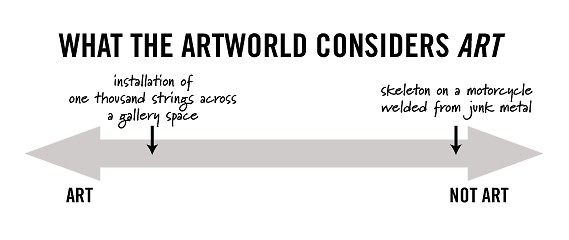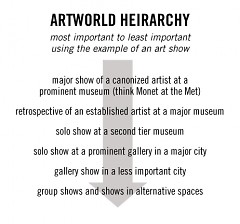ArtPrize is an unusual art event that puts local art institutions in curious position. Because ArtPrize is essentially a large group of separate art shows, many different types of venues are involved, from museums to restaurants. The artwork varies tremendously in style and quality. A viewer’s opinion about an artwork is influenced by its location, and in any community art institutions such as museums and galleries are generally expected to be the places showing the “best” art. Unfortunately this can lead to broad value judgements about the art based on location. Artists and art communities that are not normally associated with art institutions can end up being treated somewhat dismissively.
ArtPrize functions differently than most art shows. Normally a major art show is curated. Curated means that an art professional decides what gets in. Additionally, the curator or a group of jurors usually pick what they think is the best work and give that artist money (and status). In contrast, ArtPrize is a show where a sizable amount of money is awarded to an artist based on popular opinion. The venues that host the artwork can hire an art professional to curate for them, but they are not obligated to do so.
Grand Rapids art institutions participate in ArtPrize with professionally curated and installed shows. However, there is a tension between a carefully curated show in a gallery setting, and crazy anything-goes work in a parking lot. ArtPrize throws together everything in one event. Same rules for everyone. Of course, some of the curated venues take pains to set themselves apart, but you can only do so much.
Arthur Danto’s institutional theory of art can shed some light on this tension. Danto provides a simple way to tell art from non-art. If the artworld recognizes it as art, it is art. If the artworld does not recognize it as art, it is not art. The artworld is a network of art institutions: museums, galleries, art schools, art markets, curated exhibtions and magazines. Artists and art communities can be very aligned with this network or hardly aligned at all. For instance, conceptual artists rely on the artworld to validate that what they are doing is indeed art. On the other hand, an artist who welds sculptures of skeletons on motorcycles is probably not looking for artworld validation. This type of work may not even be on the artworld radar. So is it art according to this theory? When shown at ArtPrize, yes, because ArtPrize itself is an artworld institution, albeit an unusual one. The moment the motorcycle sculpture is displayed in the context of ArtPrize (the defining institution) it is art. However, this type of work would not be broadly accepted by the artworld as art, and therefore remains on the margins. At ArtPrize you get a mix of art that fits nicely into artworld conventions, and art that is at the boundaries of what the artworld considers art.
Last year Matthew Power wrote a piece on ArtPrize for GQ. Power’s article shows another dynamic at play: the hierarchy within the artworld system. A consistent undercurrent in the article is the view that an art center like New York is the cultural apex. When the view turns to “flyover country,” the assumption is that there will mostly be second-best culture and art. Nothing of real importance can happen in a place like Grand Rapids because it is too far down in the artworld and cultural hierarchy, too much of a backwater. This is the way the artworld networks function. If you are an artist or art professional working in these networks you have to accept this pecking order whether you like it or not.
What we have then are two dynamics occurring simultaneously. Grand Rapids art institutions have to navigate this unfamiliar territory of how to be at the same event with what they may consider non-art or low-quality art. At the same time, they have to be concerned about what the broader artworld thinks about a show that welcomes (to the artworld) questionable art and how participation in that show might affect their reputation.
This tension can infect the tone of the dialog when people discuss ArtPrize. The condescending tone Power takes toward Grand Rapids and ArtPrize exists within the local community also. Local art professionals, artists and viewers at times speak dismissively about what they consider the non-art or low-quality art at ArtPrize. The target of this disdain is often the artists and art communities that lie outside the artworld systems. They are the makers of junk sculpture, religious paintings and quilts, works depicting robots, skeletons and dragons. What is worrisome to me is when these discussions take on a moral tone. The assumption is that compared to artworld sanctioned work, art at the boundaries and the people who make it have less value. I am not talking here about quality or artistic merit. That is another (thorny) issue. Implied in these discussions is that this type of art doesn’t matter.
I believe this can be damaging to community. All the art at ArtPrize, whether it fits into current artworld expectations or not, should be valued and treated respectfully. Contemporary philosopher Nicholas Wolterstorff has written extensively on both art and ethics and his ideas speak to this issue. Central to his ethical philosophy is that all people have worth, and that this worth means that all people have a right to a level of respect that befits that worth. In his recent theories of art, Wolterstorff also states that artworks have an intrinsic worth. This is a worth that stands apart from any utilitarian function the work may have such as providing an aesthetic response or adorning a room. This intrinsic worth requires that we give artworks a level of respect that befits that worth. This respect is due also to the artists, and the art communities in which they work. You might not like that junk metal sculpture, but dismissing it denigrates the artwork and the artist who made it.
Artists, viewers and institutions are welcome to play the artworld game of ”art/not art,” but have no right to disparage work that lies at the edge or outside their self-created boundaries…our community must rise above that. Even in the face of big-city and artworld scorn.
The Rapidian, a program of the 501(c)3 nonprofit Community Media Center, relies on the community’s support to help cover the cost of training reporters and publishing content.
We need your help.
If each of our readers and content creators who values this community platform help support its creation and maintenance, The Rapidian can continue to educate and facilitate a conversation around issues for years to come.
Please support The Rapidian and make a contribution today.

